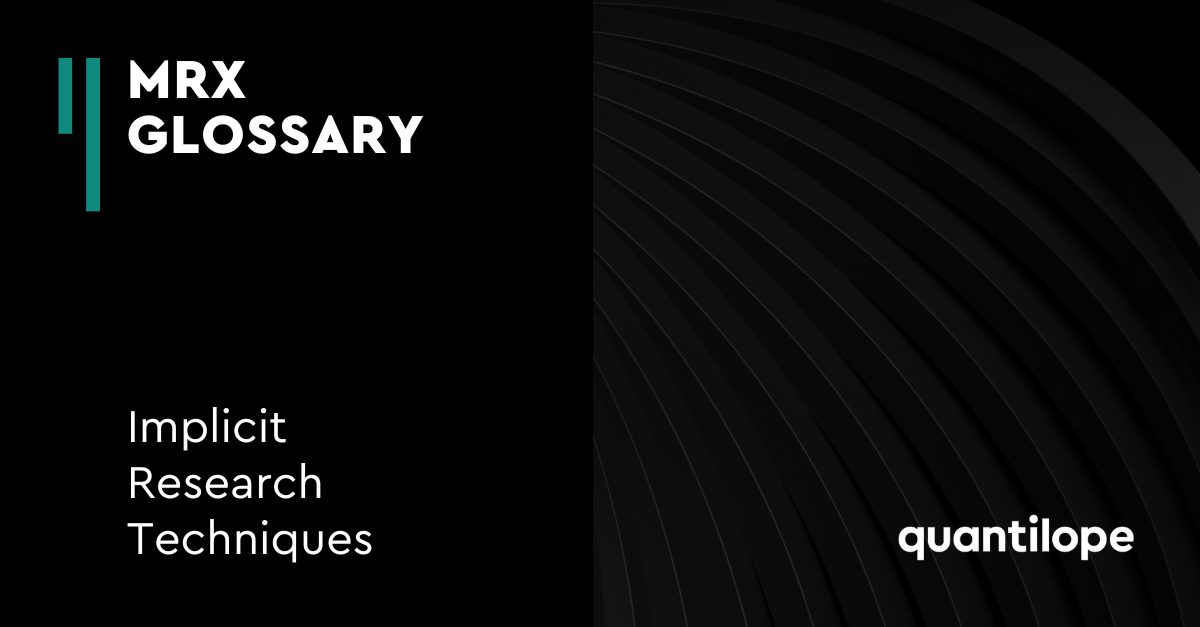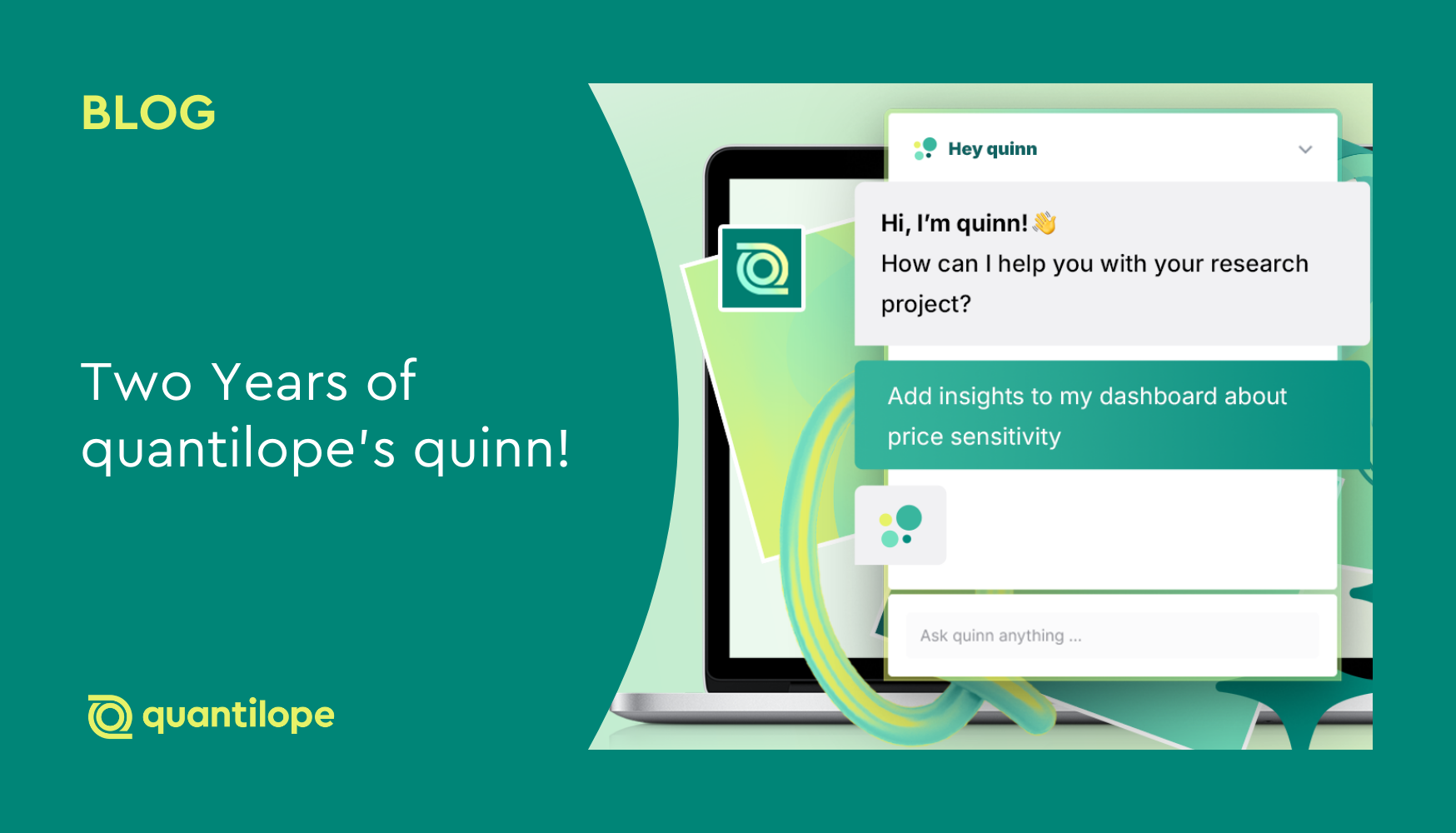This blog explores various implicit research techniques and how implicit research solves many of the limitations often found in explicit research.
Not all research methods entail explicitly asking consumers for their opinions on your products in hopes to answer your business questions. In fact, some research methods have been designed to uncover subconscious consumer sentiment, which can often be more powerful than having them plainly state their answers. These types of research, referred to as implicit research methods, should be a part of every organization’s research process.
Table of Contents:
- What are implicit research techniques?
- How implicit research overcomes research biases
- Best implicit research methods
- Summary
What are implicit research techniques?
Implicit research employs what is often categorized as “System 1” learning, popularized by Daniel Kahneman, which refers to a type of thinking that more closely follows a gut response or immediate reaction than any form of deep thinking. Though this sounds scientific, there are real-world use cases of this science for every business. Some of these use cases relate back to very common research questions, such as brand perceptions, product associations, packaging perceptions, advertisements, etc. Utilizing implicit research techniques for your brand can greatly elevate your consumer research process.
Back to Table of Contents
How implicit research overcomes research biases
Potential bias in explicit research methods
Implicit research allows brands to see what biases exist. When a respondent has an infinite amount of time to answer a scaled question in an explicit research study, some will become cognizant of their bias and answer what they think they should say rather than what they truly feel — when in reality, the latter is more important for brands. This is just one way in which implicit research is unique to other research methods and gives brands a better understanding of how consumers will truly respond to their products. Below are a few additional advantages of using implicit research.
Advantages of implicit market research
Using implicit research allows brands to tap into powerful research where explicit research methods can fall short. Explicit market research makes an assumption that we can ask consumers questions directly, then take their answers literally for findings. In many cases, this is true, but as human psychology is complex, so is the way that responses need to be analyzed at times.
Accurate reflection of thought processes
We have all seen questionnaires that utilize many scaled questions. These explicit methods, whether 3, 5, or 7-point scales, can become cumbersome and repetitive. Beyond this, they typically give respondents an unlimited amount of time to answer. This can be problematic because it’s not how associations are typically processed in a real-world setting. Are you a fan of Apple as a company? What about Tesla? Amazon? You probably answered each of those questions within a split second, rather than having to dive deep into thought. And this is the exact process that implicit research is built around.
Measuring the strength of associations
Further, it’s common in implicit methods to not just measure what the response is (for example, whether a consumer thinks Apple is innovative) but to what strength they feel that is true. Rather than defining that strength as selecting a point higher on the scale (i.e. point 7 instead of point 6 on a 7-point scale), the speed of answering or engaging with the question is also used to determine the strength of an association (i.e. reaction time). The strength of an answer in implicit research is also partially determined by which selection a respondent makes first (when selecting multiple responses at a single question).
Emotional understanding
Lastly, implicit research provides a reliable way to read consumers’ emotions. Emotions in research are complicated, as humans naturally struggle to put their feelings into words, causing them to struggle when answering thoughtful questions. However, implicit’s system 1 approach seeks an immediate response, typically providing a stronger, more reliable read by eliminating the deep thought process.
Back to Table of Contents
Best implicit research methods
There are various ways to implement implicit research methods into your regular research toolbox. These methodologies will also vary in use cases as well, so understanding where each will fit into your portfolio is crucial.
1. Implicit association test
Implicit association tests (sometimes called IAT) work by presenting stimuli to a respondent and capturing their instinctual reaction to them. This will often be in the form of perceptions or associations and reacting to whether or not they agree with them. In the actual exercise, they will often select keys on their keyboard as their way of indicating whether or not they associate the stimuli with a given adjective (i.e. pressing ‘A’ if they agree and ‘L” if they do not agree). The quicker the speed of answering, the stronger the association will be with this measurement method. Although slower answering speeds will often indicate a weaker association, it’s also common for these speeds to represent no association at all if the answer given takes longer than a specified amount of time.
To ensure respondents are prepared for the time-sensitive exercise, they first go through a brief training module mimicking what they will see in the real exercise. Within this module, a respondent’s answers are typically normalized as well — which allows the analysis to differentiate between someone who simply answers quickly by nature and someone who very strongly associates items with given terminology. The setup and calculations of scores look to eliminate (and control) any factors that could impact results outside of a pure system 1 response to the stimuli.
quantilope is a platform that offers two different forms of implicit association testing: a Single Association Test (SAT) and a Multiple Association Test (MAT). These forms are very similar, with the key difference being that an SAT allows respondents to evaluate a single piece of stimulus in isolation, while an MAT allows a respondent to evaluate multiple items at once. Using a previous example, an SAT could be used to have respondents review Tesla on its own, compared to an MAT allowing respondents to review Tesla along with key competitors such as Ford, Volkswagen, etc., all at once.
Learn more about quantilope's implicit testing below:

2. Neuroscience
Neuroscience is another way to measure consumers’ implicit reactions toward something. Two common ways to use a neuro approach are through Functional Magnetic Resonance Imaging (fMRI) or Electroencephalogram (EEG).
The former, fMRI, uses imaging to map brain activity through blood flow. The idea is that blood flow and neuroactivity are related so that emotions and responses identified in the brain can help predict consumer behaviors (such as buying behavior and sales); that’s because consumer behavior is largely determined by underlying and subconscious thoughts and emotions rather than rash decisions. Neurons that are more active when viewing a visual stimulus (such as an ad concept, branding materials, or package types) consume more oxygen than neurons that are inactive, and the active neurons are the ones that are shown on a 3D fMRI scan.
Similarly, Electroencephalogram (EEG), is used in consumer research to measure subconscious reactions to visual stimuli, but this approach works by placing electrodes of small metal discs with thin wires directly on a respondent’s scalp (looking similar to a bathing cap). This device is able to then detect the activity of thousands of neurons within a participant’s brain, recording activity in lines on a digital screen. Peaks and valleys within these lines indicate periods of high or low brain activity and can be traced back to the visual stimuli presented during those times.
Both of these approaches are great in capturing passive, subconscious emotions to visual stimuli with direct access to brain activity and digital imaging.
3. Eye Tracking
Fighting for a consumer’s attention on the shelf is an ongoing battle and one that brands should be looking to get a leg up on wherever possible. One way to do this is through an insights measurement method called eye tracking. Eye tracking allows a brand to put stimuli in front of a respondent and track what points of that stimuli first grab a consumer’s attention, using a webcam. This technology also has the ability to track the order of the viewing, creating a storyline of viewing for brands to understand.
Instead of asking direct questions, consumer behavior through eye tracking is passively observed, similar to what would happen when a consumer is standing right in front of a shelf in the store. Brands can answer crucial questions through the use of eye tracking, such as: Is the brand logo what catches consumers’ eyes first? Is additional imagery of the product being seen early and often? Are product claims such as ‘healthfulness’ or being ‘premium’ seen by consumers?
4. Biometrics
Similar to eye tracking, we now have the technology to read consumers’ facial muscles, sweat skin responses, and heart rates through biometric testing.
Facial Tracking:
Biometrics allow us to track participants’ facial muscle movements that can indicate emotional responses to visual stimuli (such as video advertisements). As a result, brands can see if their advertisement is evoking the desired emotion in consumers, and evaluate whether the ad was successful or not.
At a micro level, facial tracking can answer questions like: Are key parts of our ad achieving the expected reaction? Are there drawn-out lulls of attention at any part of the advertisement? Are any parts of the advertisement drawing an unexpected reaction such as confusion or sadness?
Advertisement evaluation is just one use case for this type of implicit measurement. Facial tracking can be used as a form of implicit research for brands seeking answers to a variety of other use cases - such as seeing facial reactions to a potential brand spokesperson, music choice, or packaging type.
Skin responses:
You might identify with the fact that your hands get really clammy when you feel nervous, or you start to sweat right before a big presentation. These are subconscious reactions to an event that can be measured through a technique called Galvanic Skin Response (GSR). This form of biometric measurement is able to identify when respondents are feeling anxious, threatened, joyful, or excited by measuring changes in their sweat gland activity through a connected physical device on their skin.
Brands might use this while showing a respondent a video advertisement or a sitcom trailer, and seeing during what time markers their sweat activity changes on their fingertips.
Heart rate:
A third way to use biometrics in implicit research is by measuring respondents’ heart rates. Similar to sweat production and brain wave activity, heart rate is something that subconsciously changes in an instant as a result of external stimuli. In the same way you might start to sweat before a presentation, your heart rate starts to accelerate when something shocking, exciting, or scary occurs. Biometrics can be used to measure this sort of heart rate reaction as it relates to consumer behavior.
Respondents will be presented with a variety of stimuli that a brand would like to test, and changes in heart rate are monitored to identify which parts of a video ad, in-store experience, or online shopping ad pop-up caused a shift in a viewer’s resting heart rate. Brands can use this data to ensure their collateral is evoking the emotions they want, and at the right times.
Back to Table of Contents
Summary
Implicit research adds a dynamic element to your research with unique use cases. Whether through implicit association testing, neuroscience methods, eye tracking, or biometrics, there are multiple ways to implement implicit testing to help drive your brand’s decision-making process.
To find out more about leveraging implicit research techniques for consumer insights, get in touch below:




.png)